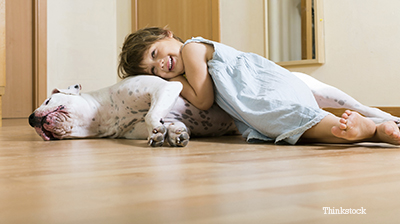
Call me an uptight veterinarian or an overanxious mom if you like, but I get a deep-in-the-gut unsettled feeling every time I view a particular type of pet photo that has become all the rage these days, particularly on Facebook. I’ll bet you’ve seen these photos—the ones in which pets and young children are posed together. Have you seen the one of the newborn baby practically buried under the massive head of the family dog? How about the image of a young child carrying (dangling) a kitty by one leg? And then there is the photo that frightens me the most—the one in which a youngster is face-to-face with the muzzle of a dog, and the expression on that dog’s face is usually one of confusion or subjugation. When I view these images I cringe, wondering if and when that animal is going to lash out at that young child. I have the desire to shake the photographer while screaming, “Danger, danger!” These “kids and pets” photos are as anxiety producing for me as a high budget suspense movie.
What made Big Ben snap?
I’d like to tell you about Ben, a patient of mine many years ago who helped set the stage for my “nervous condition.” One or two adults along with two young children typically accompanied this lovely Saint Bernard to his appointments with me. The children were always busy interacting with their dog. At any given moment one might be dragging Ben around the room by his collar. Whenever Ben did manage to lie down, he was treated like a beanbag chair, the two children leaping and falling onto his soft belly. Ben always remained the gentle giant, ridiculously tolerant of the children’s disrespectful behavior. My attempts to tactfully educate the parents about setting limits for their kids failed miserably. They reassured me that their children were simply demonstrating love for Ben who, in return, would never dole out anything but affection.
I was saddened but not surprised to receive a phone call from the children’s mother asking if I knew of anyone who might be willing to adopt Ben right away, and it needed to be a home without children. It seems that Ben finally snapped, both literally and figuratively. He bit the youngest child in the face prompting an emergency room visit and extensive reconstructive surgery. The child would be permanently scarred (likely emotionally as well as physically) and the family needed to re-home Ben or have him put to sleep. Much as we tried, a suitable home for Ben could not be found. I remember crying as I set about the task of euthanizing my beautiful and dignified patient.
Respect and safety for dogs and kids
When it comes to teaching young children about interacting with animals, I am all about two things: respect and safety. The respect part of the equation translates into a child behaving gently and kindly toward animals—no tugging on ears or tails, placing fingers inside mouths, pulling on collars, using the animal as a body pillow, lifting the animal without help from a grownup, or interrupting sleep or meals. Such respect is not intuitive for most youngsters. It is something that must be taught and carefully supervised—no different than when teaching other important life lessons such as the danger of running into the street.
The safety piece is simple. Neither the child nor the animal should sustain injury as a result of their interactions. I would need dozens more fingers and toes to count the number of animals I have treated who have been unintentionally injured, often seriously, by the actions of a young child. Flip the coin and ask seasoned emergency room physicians how many young children they have treated who were injured by the family pet. They too would need more fingers and toes.
What you can do to keep dogs and kids safe?
Here are some things you can do to enhance safe and respectful interactions between young kids and animals.
- Actively teach young children how to interact with animals in a gentle, respectful fashion. Demonstrate this behavior every chance you get.
- Be reminded that every animal is capable of unpredictable behavior. Never leave a young child unsupervised with an animal, even if that animal happens to be the beloved family pet.
- An eating or sleeping animal is wearing a “do not disturb” sign which should be respected.
- Allow a crate or other small, enclosed shelter to be an animal’s sacred space. Bar entry to a young child.
- Avoid subjecting your pet to unnatural, uncomfortable poses for the sake of a photo!
If you have any questions or concerns, you should always visit or call your veterinarian -- they are your best resource to ensure the health and well-being of your pets.
